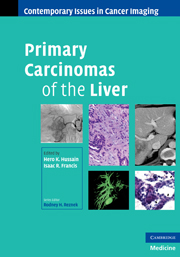Book contents
- Frontmatter
- Contents
- Contributors
- Series foreword
- Preface to Primary Carcinomas of the Liver
- 1 Epidemiology of hepatocellular carcinoma and cholangiocarcinoma
- 2 Surveillance and screening for hepatocellular carcinoma
- 3 Pathology of hepatocellular carcinoma, cholangiocarcinoma, and combined hepatocellular-cholangiocarcinoma
- 4 Radiological diagnosis of hepatocellular carcinoma
- 5 Staging of hepatocellular carcinoma
- 6 Surgical treatment of hepatocellular carcinoma: resection and transplantation
- 7 Non-surgical treatment of hepatocellular carcinoma
- 8 Radiological identification of residual and recurrent hepatocellular carcinoma
- 9 Radiological diagnosis of cholangiocarcinoma
- 10 Staging of cholangiocarcinoma
- 11 Treatment of cholangiocarcinoma
- 12 Uncommon hepatic tumors
- Index
- Color plates
- References
12 - Uncommon hepatic tumors
Published online by Cambridge University Press: 04 August 2010
- Frontmatter
- Contents
- Contributors
- Series foreword
- Preface to Primary Carcinomas of the Liver
- 1 Epidemiology of hepatocellular carcinoma and cholangiocarcinoma
- 2 Surveillance and screening for hepatocellular carcinoma
- 3 Pathology of hepatocellular carcinoma, cholangiocarcinoma, and combined hepatocellular-cholangiocarcinoma
- 4 Radiological diagnosis of hepatocellular carcinoma
- 5 Staging of hepatocellular carcinoma
- 6 Surgical treatment of hepatocellular carcinoma: resection and transplantation
- 7 Non-surgical treatment of hepatocellular carcinoma
- 8 Radiological identification of residual and recurrent hepatocellular carcinoma
- 9 Radiological diagnosis of cholangiocarcinoma
- 10 Staging of cholangiocarcinoma
- 11 Treatment of cholangiocarcinoma
- 12 Uncommon hepatic tumors
- Index
- Color plates
- References
Summary
Although hepatocellular carcinoma (HCC) and cholangiocarcinoma comprise the majority of malignant primary hepatic carcinomas, a variety of lesions are frequently found in the liver. Common lesions such as hepatic hemangioma, focal nodular hyperplasia, and metastatic disease are well known to clinicians and have been extensively documented in the literature. However, in centers with highly active liver surgery programs, other rare neoplastic and tumor-like conditions can be seen. It is important to understand these conditions in order to guide workup and differentiate management from that of primary hepatic malignant conditions.
Angiomyolipoma
Hepatic angiomyolipoma (AML) is a mesenchymal neoplasm that contains varying amounts of three discrete histologic elements: smooth muscle cells, blood vessels, and adipose tissue. Although the presence of these three elements is considered central to the diagnosis of AML, the varying content of these components can create some diagnostic uncertainty. In fact, the lipid content seen in pathologic specimens has been reported to vary widely, which has led some researchers to subcategorize hepatic AML into four different types based on lines of differentiation and dominant tissue component: mixed, lipomatous (>70% fat), myomatous (<10% fat), and angiomatous. However, modern immunohistochemical techniques have markedly increased lesion specificity through positive staining for HMB-45 myoid cells.
- Type
- Chapter
- Information
- Primary Carcinomas of the Liver , pp. 214 - 232Publisher: Cambridge University PressPrint publication year: 2009



